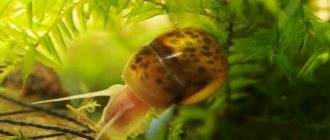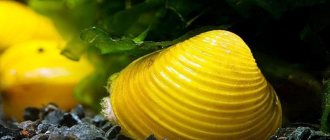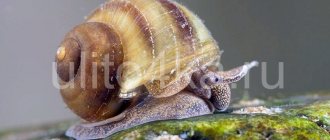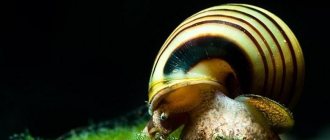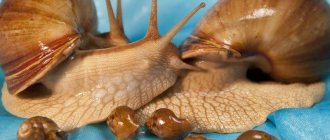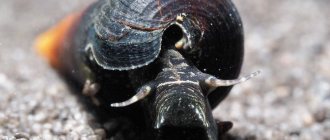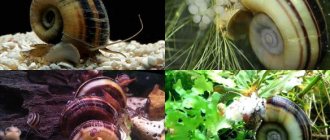Everything you wanted to know about ampullaria snails...
Ampularia (lat. Pomacea bridgesii) is a large, bright and popular aquarium snail. It is not difficult to maintain, but there are important details in feeding. Originally from the Amazon, where it lives throughout its entire length, it has eventually spread to Hawaii, Southeast Asia and even Florida.
In nature, ampullaria spend most of their lives in water, emerging only by chance and during reproduction to lay eggs. And yet, although they spend most of their lives underwater, they need atmospheric oxygen to breathe, for which they rise to the surface.
You can often observe how an ampoule in an aquarium rises to the surface, extends its breathing tube and begins to pump oxygen into itself. Its respiratory system is comparable to the lungs of a fish, having gills (on the right side of its body) and lungs on the left side.
Aquarium ampullaria snails have adapted very well to life in the tropics, where dry periods alternate with the rainy season. This was reflected in their body, they developed a muscular leg with a protective flap attached to it. With the help of this valve, they close their shell to survive in the remaining water and dirt during the dry period.
They live in all types of reservoirs, in ponds, lakes, rivers, canals. Despite the fact that many snails are hermaphrodites, ampullaria are heterosexual and require a partner to reproduce.
Although the most common color is yellow, they still come in many different colors. In addition to yellow ampoule, you can find white, brown and even almost black. Nowadays blue ampularia have become fashionable, but they are not particularly different from yellow ones in maintenance and breeding. When you buy one, it is important to remember that it grows much larger than other snails. They are sold quite small, up to 2.5 cm in diameter, but they can grow to a size of 8-10 cm. There are also larger ones that are very well fed, and they become so large that they can compete in size with other giants - marise snails.
The aquarium contains several different types of ampularia, which differ from each other in the shape of the shell. The lifespan of ampularia in an aquarium is 2 years.
Keeping ampularia in an aquarium
If kept alone, a very small aquarium, about 40 liters, will be enough for them. Since snails eat aquarium ampularia, they eat a lot, and there is also a lot of waste after them, it would be correct to allocate at least 10-12 liters of volume per one. Considering that they reproduce quite vigorously, it is not worth keeping them much.
But, since ampullaria themselves are rarely kept in the aquarium, it is better to count on a larger aquarium volume. So, for 3-4 snails + fish, you need about 100 liters. Of course, a lot depends on your conditions and details. But as a rule, 10 liters per ampoule will not let you down.
Yellow ampullaria are completely peaceful and never bother fish or invertebrates. There is a misconception that they attack fish. But this is due to the fact that snails are scavengers and eat dead fish, but it seems they killed the fish. Not a single snail is capable of catching up, catching and killing a healthy and active fish.
But ampularia fish are very disturbing. They can tear off their antennae, such as the Sumatran barbs, or even completely destroy them, such as dwarf tetradon, fahaka, green tetradon, clown botia or large cichlids. Some will not be able to eat large snails, but they will clean up small ones. And they will gnaw large ones at every opportunity, which will not improve their health either. Invertebrates such as shrimp and crayfish can also become a problem; they expertly pick snails out of their shells and eat them.
Organs of vision and breathing
Feeding
Breeding ampularia
Most popular questions:
Feeding
What to feed the ampoule? It's very simple, they eat almost any type of food. In addition to the fact that they will eat all types of food that you give them, they will also eat everything that they can find in the aquarium.
The advantage is that they finish the food after other inhabitants, preventing them from rotting and spoiling the water.
The easiest way to feed them is with catfish tablets and vegetables. They especially love cucumber, zucchini, lettuce, even pumpkin. Two conditions must be observed - boil the vegetables for a couple of minutes and do not keep them in the aquarium for more than a day, as the water becomes very cloudy.
They also eat live food with pleasure; I have had them eat bloodworms and tubifex. But here they need to be able to get to it, that is, a clean bottom, and in a general aquarium, as a rule, the food has time to fall into the ground.
But remember that snails easily damage young leaves of plants and tender species, eating them up to the trunk. To prevent this from happening, you need to feed them plenty of vegetables and food containing spirulina.
Breeding
Unlike many aquarium snails, they are not hermaphrodites and you need a male and female for successful breeding. The easiest way to get such a pair is to buy 6 snails at once, which practically guarantees individuals of different sexes.
When they become sexually mature, they will begin to breed on their own; no action needs to be taken to stimulate them.
How to understand that this happened? During mating, the male and female merge with each other, with the male always on top.
After mating is complete, the female climbs out of the water and lays a large number of eggs above the surface of the water. The caviar is pale pink in color and should be above the surface of the water, without plunging into it, otherwise it will simply disappear.
The surface of the caviar calcifies under the influence of air and the babies are completely safe.
The small snails hatch after a few weeks, provided the ambient temperature is 21-27°C and there is sufficient humidity. Newborns are quite large, fully formed and do not require any special care.
Ampularia caviar in nature
Ampularia does not move
To damage from the external environment, ampullaries respond with stress, which affects almost all systems of the small organism. This reaction allows us to judge the level of general environmental toxicity. In this case, the negative impact can be exerted not by just one toxic substance, but by a complex of them.
Snails have gills and lungs. In water where oxidation is low, these pets breathe using gills. At the same time, they swim to the surface to ventilate their lungs about once every 10 minutes. Sometimes this period can be quite long. And this does not interfere with their activity.
If the surrounding conditions are good enough, the ampullaria actively move. But even if the ampularia does not move, this may be the first sign of poor water quality. This exact behavior can be seen when detergent gets into the aquarium.
Aquarium ampularia snails - care and reproduction
Description
Content
Reproduction
Ampularia are heterosexual snails, but it is not possible for humans to distinguish between male and female. To be sure, keep at least 4 pieces in one aquarium. If you notice who exactly is laying eggs, mark it or remember it so that next time you can definitely know the female. Some snail lovers are able to distinguish the sex by looking under the cap, but this method often fails and is not one hundred percent accurate.
Surprisingly, the female lays eggs on the surface of the water. The ready female crawls to the surface and examines possible oviposition sites. At such moments, you need to cover the aquarium with glass to eliminate the possibility of escape. Please note that even the smallest specimens of ampularia are capable of lifting light glass, so place a weight. Typically, the snail only tries to lay eggs in the evening, so pay attention to the aquarium in the late hours to avoid losing the snail. The female chooses the ideal place on her own. You should not touch the caviar. The only case is if she is in close proximity to a lighting fixture and may die from high temperature. Carefully pick it up and place it on a piece of foam or wood chips on the surface of the water.
The female lays large eggs, the diameter of each of them reaches 2 mm. After the calf passes along the genital crease of the leg, it begins to harden. This process takes about a day. Now, the laid eggs look like a pink bunch of grapes. After this, the masonry begins to change color. You can track the metamorphoses from the photo. The darker the clutch, the closer the moment of appearance of the young animals. It takes about 3 weeks to ripen. If the clutch is in a common aquarium, then only a few mollusks have a chance to survive.
How to distinguish melania from Helena?
Sink helen
painted in alternating stripes of black and yellow.
These snails are almost always in search of food. They cope with coils and physicals without any problems. It’s a little more difficult with melania, but when they eat all the phys and coils, they will switch to melania
.
Interesting materials:
How to clear cookies in Opera? How to clean a wooden floor? How to clean carbon deposits from an electric waffle iron? How to clean fugu from impurities? How to clean granite stone? How to clean dirty sofa upholstery? How to clear Yandex navigator? How to clean a cauldron until it shines? How to clear cache in Counter Strike GO? How to clean a metal barrel of diesel fuel?
Snails at the top does this mean low oxygen?
Fish often swim from above and seem to grab the air and snails, of which there are a lot, all crawl to the top. Maybe this is a signal of insufficient oxygen due to the relocation of the aquarium. There are a lot of plants, but there are a lot of guppies and snails.
Definitely - there is little oxygen in the water, urgently install an aerator
Own on Aqa.ru, Advisor
Andrew5 Maybe there’s nothing wrong. Guppies usually stay in the upper layers of water, snails often float to the top to replenish their air supply, regardless of the oxygen content in the water. But if the fish constantly seem to “suck” the surface of the watershed, then there is a problem. In this case, it is necessary to ensure good water circulation in the aquarium with a filter or aerator. It is advisable to regularly replace 20-40% of the water once a week with fresh water at aquarium temperature (you can use unsettled water, mixing hot and cold from a mixer) Good luck
Aeration or movement of water from the pump. It is also advisable to change 25% of the water.
And if you smell the water, it doesn’t smell like anything?
Yes, and the filter would be cleaned in one go. Maybe the remaining food in it spoils the water.
The filter works continuously, and I don’t change the water, I only clean the filter once every 3 days. The catfish are alive, the guppies too, but the barbs didn’t like the situation in the aquarium, so I was puzzled. Countless gray, yellow large snails can significantly affect oxygen levels? The snails “rise” especially noticeably when the lights are turned off, it happens like a strike - everything is on top in a row.
Modified 10/13/08 by Andrew5
What filter do you have? If it’s biological, then you don’t need to clean it every 3 days! Or do you only have a mechanical filter (sponge)?
Only mechanical Polish, it clogs a lot. The water does not smell of anything; I periodically remove plant leaves from the surface. I think we need to siphon the soil thoroughly, otherwise catfish sometimes raise a storm. The question is off-topic: how to separate the female from the male in torocatums, I have one with a crescent-shaped abdomen, the rest are smooth, so big they have grown, and suckers who are less afraid of them. And one of the suckers is much larger than the others, even though I bought identical fry.
Features of behavior
Many novice ampoule owners often wonder: why are their pets inactive, despite proper care and well-fed food?
Mollusks are lazy by nature: they usually move only to satisfy hunger and reproduce, and they prefer to spend the remaining time after these important activities sleeping. Excessive laziness may be a consequence of keeping pets at low water temperatures, and also indicate their advanced age.
Sometimes gastropods can swim for a long time at the surface of the water. This happens when they take in too much air into the lungs, turning into a kind of “float”.
However, sometimes the inactivity of an aquarium inhabitant means its death. Remove the pet that shows no external signs of life from the pond. If he closes the sink valve, everything is fine. If the snail does not move, its body falls out of the house and emits an unpleasant odor - it is dead.
Dead individuals must be urgently removed from the tank: the decomposition process is intense and can lead to severe water pollution.
Why does the Achatina snail not burrow into the ground?
Hello my dear friends (let me address you). I would like to thank you for the comments on the posts and the letters that come from you by email. A few days ago I received a letter.
In it they asked me: “why doesn’t the Achatina snail burrow into the ground”? After all, she used to rest in the ground, but now she prefers to doze, hanging on the wall and lid of the terrarium. She eats well and is active. The usual soil for keeping it is coconut substrate. I don't know what to do. I want to say right away that there is nothing wrong with a snail not burrowing into the ground if it is active, eats well and grows. If you disagree, write your point of view in the comments.
The behavior of a domestic snail is sometimes difficult to understand by human logic. Some species of African snails prefer to burrow into the ground and leave it only while eating. Other species spend most of their time on the surface in an active state. For example, if a snail is kept without soil from the first days, and in adulthood is offered a substrate, then it is unlikely that it will happily begin to burrow into it. Because I'm not accustomed.
Main reasons
1. Wet, waterlogged soil
Snails prefer a moist and warm environment, but everything needs moderation. Excessively wet soil becomes heavy, clumps and does not warm up well. There is little oxygen in it. Therefore, the snails are in a hurry to move to the wall of the container. Soil waterlogging occurs from
- frequent and abundant moisturizing;
- improper ventilation;
- frequent turning over of the water container;
- no loosening or fluffing up of the soil in the terrarium.
How to find out how wet the soil is in a terrarium? Squeeze a small lump of soil in your fist; if water flows out, then it should be dried. If it drips in rare drops, then everything is fine. You can dry the soil in the oven or squeeze it out using gauze or cloth.
Moss is often used as an indicator of soil moisture. It is placed a little on top of the soil. As soon as the moss begins to dry out, it means the humidity has decreased; if it is green, everything is in order.
Watch a video on how to make ventilation for pet snails
2.Replacement of soil or unusual substrate
Many species of African snails are very demanding on the substrate. They can take weeks to get used to fresh soil or stop going down to it altogether. When the litter is completely replaced, the snail experiences stress, as its environment around it completely changes.
Just don’t think that I am advocating not to remove or change the soil of snails. It’s just that after spring cleaning, Achatina trees need time to get used to new smells and textures. It is better to replace dirty soil in parts, mixing new soil with old.
It is believed that the best type of substrate for keeping the Achatina snail is a coconut substrate. It is neutral, inexpensive and does not stain the snail or the walls of the terrarium. But with all its advantages, it is the number one “irritant” for the mollusk. Therefore, before use, it should be rinsed with clean water to get rid of the smell of coconut and salt (coconut shells and fibers are soaked in sea water).
3.It’s cold in the terrarium
Most often, snails suffer from low temperatures in the off-season. When the central heating had not yet been turned on in early autumn or was turned off early in the spring. Therefore, you need to additionally heat the terrarium (heat cord, regular lamp).
What happens during this period? The air temperature in the terrarium is low and the humidity is high. Then the snails move to the lid of the container, since the air here is warmer. Of course, this does not apply to a critical decrease in temperature in the terrarium. At temperatures below 23 degrees, the domestic snail becomes lethargic and buries itself in the ground.
4. Not accustomed to the ground
If you become the happy owner of an adult Achatina, then by this time she has formed certain preferences and tastes. And this applies not only to food. For example, if Achatina was kept on flower soil or synthetic padding mat, then it will be difficult to accustom it to coconut soil. Or if the previous owners had her sleep in an artificially made shelter (a piece of bark, half a coconut or a flower pot with moss), it will also be difficult to force her to burrow into the ground.
However, some snail breeders resort to a little trick. And in order to accustom the snail to coconut soil, sprinkle a little flower soil (washed) on top.
5.Tight terrarium
African snails do not tolerate crowding. Therefore, be sure to increase the volume of the container as the number of snails grows or increases.
Why do small snails burrow into the ground, but large Achatinas don’t want to?
It is believed that the shells of small Achatina are thin, and the babies themselves are more susceptible to environmental influences. Therefore, by hiding in the ground they protect themselves from sunlight, high or low temperatures, predators, etc.
Well, the shells of adult Achatina reliably protect them from light. Therefore, they happily rest in a shelter or on the walls of a terrarium. The most important thing is to monitor their behavior and well-being.
So, if the snail does not burrow into the ground, it’s not scary. If the terrarium is warm and moderately humid. If high-quality soil is used, it should also be enough so that Achatina does not damage its shell when falling. If the snail is actively eating and growing.
Aquarium cleaning
This method will help get rid of melania and black snails. Cleaning is carried out as follows:
- The fish are placed in a separate aquarium.
- Drain the water.
- Remove plants and soil.
- Rinse the container thoroughly.
- All decor is washed and boiled.
- Fill in new soil.
- Wash the algae (for details, see the section “Protect the aquarium from snails”).
- The aquarium is formed again.
This is a fairly effective method. But it has a significant drawback - the aquarium needs to be started again.



